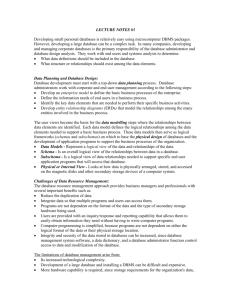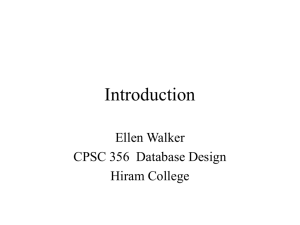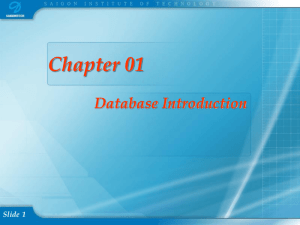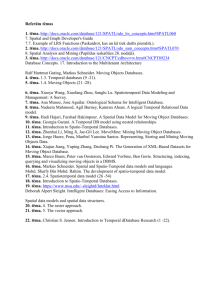Emerging Database Technologies and Applications
advertisement
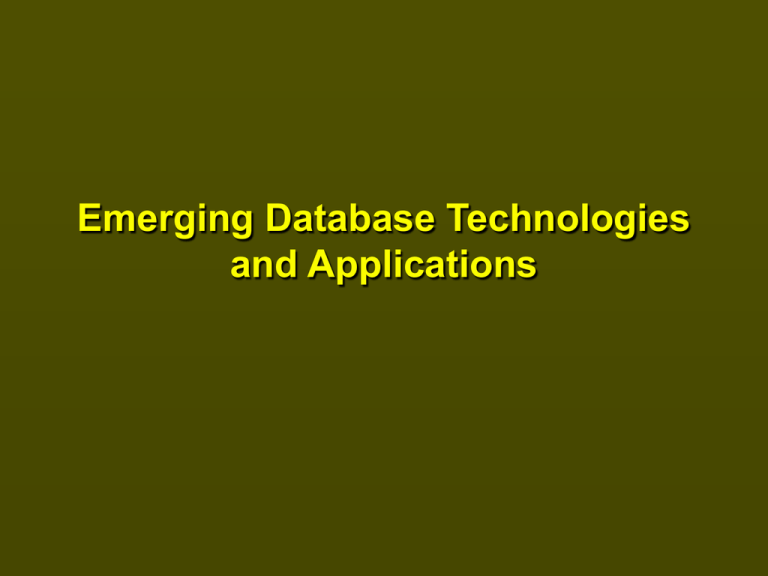
Emerging Database Technologies and Applications Progression of Database Technology 1960s to Mid1970s Network Hierarchical 1970s to Mid-1980s 1980s to Early 1990s Future Relational Database Hardware Mainframes Mainframes Minis PCs Merging data models with knowledge representation Hybrid models Client-server configuration Parallel processing Optical memories User Interface None Query languages Forms Semantic Object-oriented Logic Faster PCs Workstations Database machines Back ends Graphics Menus Query-by-forms Program Interface Procedural Embedded query languages Standardized SQL 4GL Logic programming Presentation and Display Reports Report generators Business graphics Image output Processing Processing data Data Model Multimedia Natural languages Speech input Freehand text Integrated database and programming languages Generalized presentation managers Distributed, heterogeneous data and knowledge processing with multimedia information Information and Transaction processing Parallel database transaction processing Knowledge processing management Current Trends in Technology • • • • Distributed, heterogeneous environments Open systems More functionality Parallel database management Next Generation of DBMSs • Active databases – Applications such as process control, power distribution/generation, workflow control, program trading, battle management, patient monitoring are not well served by passive DBMSs – conditions defined on states of the database must be monitored and actions taken – active databases support condition monitoring Active Databases Specification of events and conditions to be monitored Queries and updates Actions Active DBMS External events Payoffs: • No changes to applications • DBMS optimizes rules • Enhances DBMS functionality • Meet the time-constrained requirements of applications Issues in Active Databases • Efficiency – a large set of rules need to be managed and evaluated efficiently • Modes of rule execution – rules can be fired in an immediate, deferred, or detached mode in regard to the original transaction • Data model extension – specifying events, conditions, and actions • events: – database operations (insert, delete, modify) – temporal events (5 p.m. every day) – user- or application-generated events (hardware failure) Issues in Active Databases • Management of rules – ability to manipulate rules (add/delete/modify) – mechanisms for enabling and disabling rules or rule sets • Supporting DBMS functions – examples: constraint management, maintenance of derived data, rule-based inferencing • Interaction with parts of DBMS – optimization of rules requires interaction with transaction manager, object manager, and scheduler State of the Art in Active Databases • HiPAC (High Performance ACtive database system) research project at Xerox • PROBE for battle management application (Computer Corporation of America) • Event/Trigger Mechanism (Univ. of Karlsruhe) • POSTGRES (Stonebraker, UC Berkeley) • Starburst project at IBM • Sybase supports simple triggers • InterBase does not impose most of the restrictions seen in Sybase • ORACLE v. 7, INGRES, INFORMIX, etc. provide some degree of rule and trigger support Multimedia Databases • Applications: – – – – – documents and records management knowledge dissemination education and training marketing, advertising, retailing, travel real-time control and monitoring Multimedia Databases • Multimedia IS are very complex; issues: – – – – – modeling, dealing with complex objects design (conceptual, logical, physical) not researched yet storage on standard devices presents problems retrieval opens up many issues performance problem solving efforts are experimental • Databases (fixed data structure) versus information retrieval (text) perspectives • Requirements of multimedia/hypermedia data modeling and retrieval – query mechanism should have access to the links (?) Multimedia Databases • Indexing of images – automatic object identification – manual indexing • Open problems in text retrieval Multimedia information systems promise to bring about a marriage of the disciplines of information retrieval and database management Spatial Database Management • The spatial semantics can be captured by three common representations: – solid representation • the space is divided into pieces – boundary representation • the spatial characteristics are represented by line segments or boundaries – abstract representation • relationships with spatial semantics, such as ABOVE, NEAR, IS NEXT TO, BEHIND, are used to associate entities • The PROBE project provided support for spatial data Temporal Database Management • An one-dimensional case of spatial information • Includes three types of support for time: – time points – time intervals – abstract relationships (before, after, during, simultaneously, concurrently, ...) • The history aspect of databases is important for project management, patient histories, maintenance histories, etc. Temporal Database Management • A range of businesses (ex. finance, medical, legal, manufacturing) can benefit from quick access to historical and current data • Limitations of current databases: – data become valid at the time they are recorded; no provision for distinguishing between transaction time and valid time – no capability to preserve historical information • Until recently, inefficient storage capabilities made the temporal database concept not practical • WORM and compression technology made it possible Tuple Time Stamping One proposed model is the Temporal Relational Model – Attributes, relations are divided into time-varying and non-time-varying – For time-varying relations, two timestamp attributes are appended – SQL is extended into Temporal SQL (TSQL) EmpNo Salary Position Start time End time 33 20K Typist 12 24 33 25K Secretary 25 35 45 27K Jr. Engineer 28 37 45 30K Sr. Engineer 38 42 Open Problems • Reasoning with temporal information • Processing information over valid-time and transaction-time databases • Mixing temporal processing with active and deductive databases • Integrating temporal information over heterogeneous environments Update on Temporal DB Research Recent Advances in Temporal Databases, J. Clifford and A. Tuzhilin, (Eds.), Proceedings of the International Workshop on Temporal Databases, Zurich, Switzerland, 17-18 September 1995, Springer, 1995. X, 362 pp. 80 figs. Softcover $79.00 ISBN 3-540-19945-4 • • • Papers cover a wide range of topics from the highly theoretical through to reports on how temporal data bases can be used to solve real problems In addition to the technical papers, there are also summaries of two panel discussions which assess the recently-completed TSQL2 Language Design, and examine the need for additional research into the development of TSQL3 Together these papers provide a comprehensive overview of the latest research work into the area of temporal databases Also see URL: http://www.jcc.com/sql_tmpr.html Extensible Database Management • Building DBMSs out of “DBMS parts” • Assembling prewritten modules has advantages: – rapid and economical development – technological improvements can quickly be incorporated – proposed new algorithms can first be evaluated • Project GENESIS at the University of Texas – components of DBMS and interfaces among them are defined – new DBMS can be configured within minutes – plug-compatible modules are defined for access methods, query optimization, concurrency control, recovery, ... Extensible Database Management Project EXODUS at University of Wisconsin provides certain kernel facilities including storage manager and type manager – type manager permits definition of hierarchies with multiple inheritance – the storage object is a byte sequence of arbitrary size – buffer management, concurrency control, recovery mechanisms are provided and can be modified – type-independent index structures can be selected – the language E, an C extension, adds the notion of persistent objects – query processing includes query optimization and evaluation – the DBI supplies the description of operators and methods to implement them – the rule-based optimizer generates C source code – the EXODUS storage manager was used by several vendors (incl. O2 ) Full-Functionality Approach • Building DBMS with extensive functionality • Providing a wide set of features • Projects PROBE and Starburst – active databases – PROBE provides spatial query processing • POSTGRES also combines OO and active database capabilities with the relational model Unified Database Management Example of systems in this category is UniSQL – combines • power and ease of popular development tools • OO development • multimedia database integration – organization: • • • • UniSQL/X provides C/S DBMS platform UniSQL/M allows access to relational and prerelational DBs UniSQL/4GE Tools for dynamically generating applications Visual Editor and Media Master allow for viewing and editing of schemas and for sophisticated report generation – the next generation of DBMSs is likely to be patterned after the UniSQL


